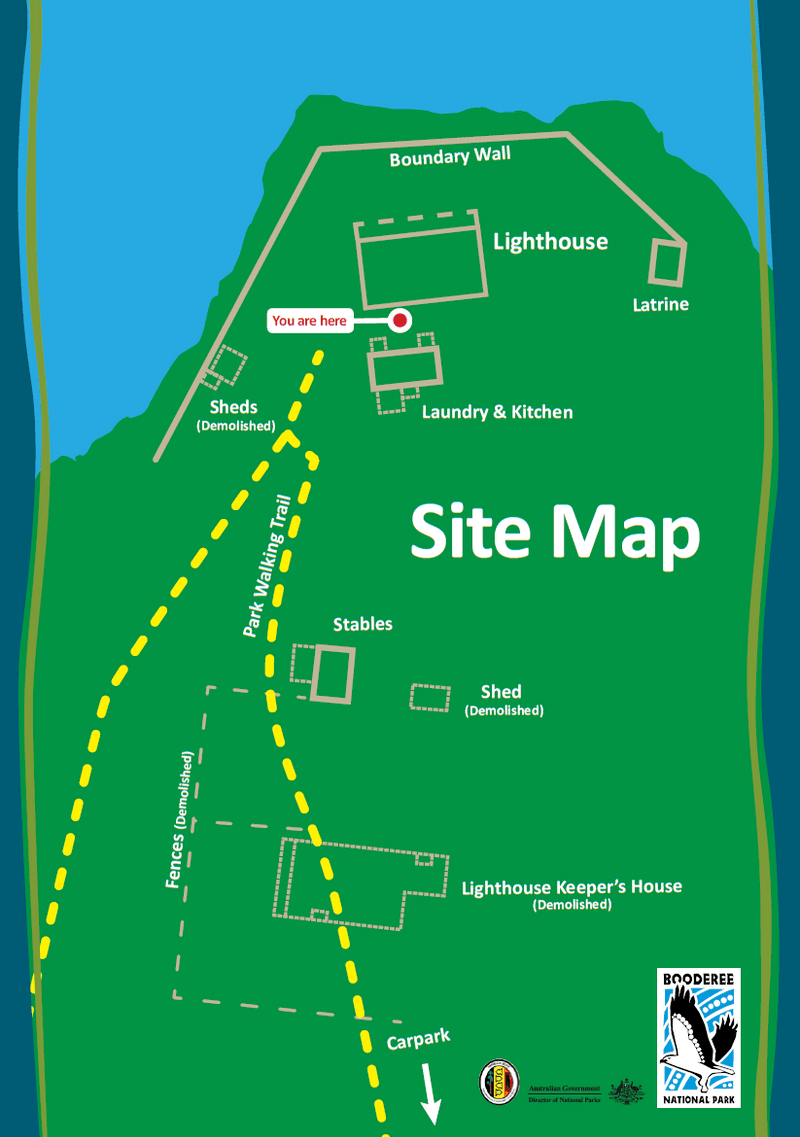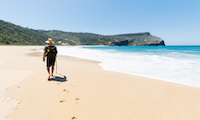Cape St George lighthouse
The ruin of Cape St George Lighthouse is perhaps the most significant European site in the park. Nowadays, the lighthouse is the best place to watch the whale migration and return. Learn more about whale-watching.
Designed by the colonial architect, Alexander Dawson and built in 1860, the 3 storey lighthouse was built of sandstone blocks quarried near the present day Jervis Bay village. The tower was 61 feet high (18.5m) with 8 rooms at ground level. The floor was timber and cast iron girders held up a roof of stone flagging covered with asphalt.
Getting supplies to the lighthouse was always difficult with the nearest landing place over 4 kilometres away at Murrays Beach. Horses were needed for transporting mail and supplies, and taking the children to and from school. Keeping a horse permanently was not easy as there was a shortage of grass
for feed. However goats were better suited to the terrain and were kept for milking, some meat for consumption and bait for catching sharks.
From 1860 to 1877 up to 15 people including the lighthouse keeper, 2 under-keepers and their families lived in this 8 room complex. Oil and supplies for the lighthouse were also stored here so conditions would have been relatively cramped and uncomfortable. In 1877 a 7-room weatherboard cottage was built for the head keeper near the stables.
The kitchen and laundry building was probably erected around 1865 as ‘a store for the men’s provisions, a wash house and an oven, with a boiling copper for the establishment’. It provided much needed space as previously everything, including living quarters for the three lightkeeper’s families, had been housed in the original lighthouse building.
The double latrine (toilet) building drains directly out and over the nearby cliff face, and is an excellent example of the strict attention to sanitation that was required in such a remote location. It is likely that it was divided into male and female sections.

Map of Cape St George lighthouse
Whilst it is a picturesque location today, the lighthouse has a fascinating and grisly history of death and disaster:
-
In 1867, Isabella Jane Lee, the daughter of the principal lightkeeper from 1863 to 1873, died of typhus fever, a rare bacterial infection spread usually by parasites.
-
In 1882, another resident, 13-year-old George Gibson, died from pleurisy. Pleurisy results in the inflamation of tissue surrounding the lungs and causes pain when breathing.
-
Typhoid struck again in 1885, killing Florence Bailey, the 11-year-old daughter of the third assistant lightkeeper. Her father, Edward Bailey, supplemented his income by fishing for sharks on the rocks below the lighthouse. In 1895, he was washed from the rocks. Entangled in his lines in heavy seas, he was taken by sharks as his son watched in horror.
-
Francis Henry Hammer, the son of Mary Hammer (a single woman who lived at the lighthouse) had a habit of pushing large rocks over the cliff edge to amuse himself. However, he tragically met his end when he either toppled over or lost his footing when part of the cliff collapsed. He was only nine or ten years old.
-
William Markham, the assistant lightkeeper from about 1878-1883, was kicked in the head by a horse and died before he reached Nowra Hospital.
-
In 1887, Kate Gibson (the principal lightkeeper’s teenage daughter), tripped while skylarking with a loaded firearm. The gun discharged, striking her friend Harriet Parker (the assistant lightkeeper’s daughter) in the back of the skull, killing her instantly. Her gravesite can be found in the Green Patch camping area.
Stay in touch
Subscribe to receive important updates about Booderee National Park.
](/static/e5dd3b5d340deb00451ac77633bfa524/d4ac0/bnp-hero-image-cape-st-george-lighthouse-2-h.jpg)






